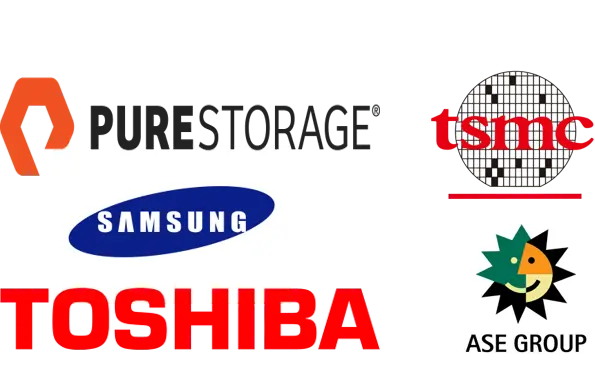Market Size of 3D TSV Devices Industry

| Study Period | 2019 - 2029 |
| Base Year For Estimation | 2023 |
| CAGR | 6.20 % |
| Fastest Growing Market | Asia Pacific |
| Largest Market | North America |
| Market Concentration | Low |
Major Players
*Disclaimer: Major Players sorted in no particular order |
3D TSV Devices Market Analysis
The 3D TSV Devices Market registered a CAGR of 6.2% over the forecast period 2021 - 2026. For saving space in the package, especially for next-generation products, and to meet the demand from edge computing applications, which require shorter reaction time and different structures semiconductor manufacturers are increasingly using silicon via (TSV) techniques for chip stacking.
- Rising demand for miniaturization of electronic devices drives the growth of the 3D TSV market. These products may be achieved by hetero system integration, which may give more reliable advanced packaging. With extremely small MEMS sensors and 3D packaged electronics, one can place sensors virtually anywhere and could monitor equipment in harsh environments, in real-time, to help increase reliability and uptime.
- 3D TSV in dynamic random-access memory (DRAM) that stores each bit of data in a separate tiny capacitor within an integrated circuit propels the growth of the 3D TSV market. Micron's 3D DRAM with re-architected DRAM achieves significant improvements in power and timing, which help in developing advanced thermal modeling.
- The recent COVID-19 outbreak is expected to create significant imbalances in the supply chain of the market studied, as Asia-Pacific, particularly China, is one of the major influencers of the market studied. Also, many of the local governments in the Asia-Pacific have invested in the semiconductor industry in a long run program, hence, expected to regain market growth. For instance, the Chinese government raised around USD 23 to 30 billion funds, to pay for the second phase of its National IC Investment Fund 2030.
- However, thermal issues caused due to a high level of incorporation is a challenging factor for the growth of the 3D TSV market. Since silicon via (TSV) provides the key connection in 3D IC integration, the difference of coefficient of thermal expansion (CTE) between silicon and copper is more than 10 ppm/K, which provides thermal stress when a thermal load is applied.
3D TSV Devices Industry Segmentation
The 3D tsv devices is a high performance interconnect technique that passes through a silicon wafer by a vertical electrical connection which lower power consumption and gives better electrical performance. On the basis of product, the sub-markets include mems, imaging, and optoelectronics, memory, advanced led packaging, CMOS image sensors, and others that drives the market.
| By Product Type | |
| Imaging and opto-electronics | |
| Memory | |
| MEMS/Sensors | |
| LED | |
| Other Products |
| By End-user Industry | |
| Consumer Electronics | |
| Automotive | |
| IT and Telecom | |
| Healthcare | |
| Other End-user Industries |
| Geography | ||||||
| ||||||
| ||||||
| ||||||
| Rest of the World |
3D TSV Devices Market Size Summary
The 3D TSV market is experiencing growth driven by the increasing demand for miniaturization in electronic devices and the need for advanced packaging solutions. This technology, which involves stacking chips using through-silicon vias, is particularly beneficial for edge computing applications that require compact and efficient designs. The integration of MEMS sensors and 3D packaged electronics allows for real-time monitoring in challenging environments, enhancing reliability and uptime. The market is also propelled by advancements in dynamic random-access memory (DRAM) technologies, which offer significant improvements in power and timing. However, challenges such as thermal issues due to the differences in thermal expansion coefficients between silicon and copper pose obstacles to market growth.
The Asia-Pacific region is the fastest-growing market for 3D TSV technology, fueled by high levels of manufacturing in consumer electronics, automotive, and transportation sectors. The region's active manufacturing hubs, coupled with the rising popularity of smartphones and the introduction of 5G technology, are creating substantial opportunities for market expansion. The market is characterized by high competition due to the presence of numerous large, small, and local vendors. Key players such as Amkor Technology, GLOBALFOUNDRIES, and Micron Technology are prominent in the market. Recent developments include Samsung's creation of a 12-layer 3D packaging for DRAM products and TSMC's certification of ANSYS solutions for advanced 3D chip stacking, highlighting the ongoing innovation and strategic advancements within the industry.
3D TSV Devices Market Size - Table of Contents
-
1. MARKET DYNAMICS
-
1.1 Market Drivers
-
1.1.1 Expanding Market for High Performance Computing Application
-
1.1.2 Expanding Scope of Data Centers and Memory Devices
-
-
1.2 Market Challenges
-
1.2.1 High Unit Cost of 3D IC Packages
-
-
1.3 Assessment of Covid-19 impact on the industry
-
-
2. MARKET SEGMENTATION
-
2.1 By Product Type
-
2.1.1 Imaging and opto-electronics
-
2.1.2 Memory
-
2.1.3 MEMS/Sensors
-
2.1.4 LED
-
2.1.5 Other Products
-
-
2.2 By End-user Industry
-
2.2.1 Consumer Electronics
-
2.2.2 Automotive
-
2.2.3 IT and Telecom
-
2.2.4 Healthcare
-
2.2.5 Other End-user Industries
-
-
2.3 Geography
-
2.3.1 North America
-
2.3.1.1 United States
-
2.3.1.2 Canada
-
-
2.3.2 Europe
-
2.3.2.1 Germany
-
2.3.2.2 France
-
2.3.2.3 United Kingdom
-
2.3.2.4 Rest of Europe
-
-
2.3.3 Asia-Pacific
-
2.3.3.1 China
-
2.3.3.2 Japan
-
2.3.3.3 India
-
2.3.3.4 Rest of Asia-Pacific
-
-
2.3.4 Rest of the World
-
-
3D TSV Devices Market Size FAQs
What is the current 3D TSV Devices Market size?
The 3D TSV Devices Market is projected to register a CAGR of 6.20% during the forecast period (2024-2029)
Who are the key players in 3D TSV Devices Market?
Taiwan Semiconductor Manufacturing Company Limited (TSMC), Samsung Group, Toshiba Corporation, Pure Storage Inc. and ASE Group are the major companies operating in the 3D TSV Devices Market.

